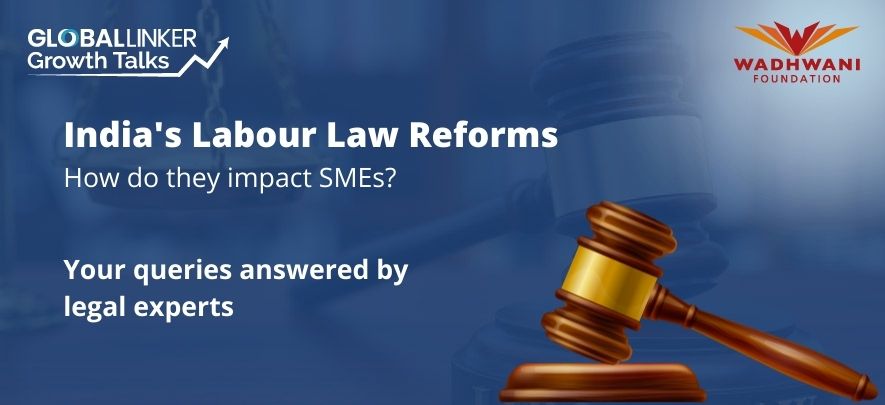India’s new Labour Laws: Your queries answered by legal experts

Legal & Compliance
213 week ago — 14 min read
In September 2020, India embarked on a major initiative of Labour Law reforms. With a view to reform archaic Labour Laws and improve India’s position in the global ‘ease of doing business’ rankings, around 44 central laws were consolidated into 4 Labour Codes.
- Wage Code, 2019 (Code on Wages)
- Social Security Code, 2020 (SS Code)
- Occupational Safety, Health and Working Conditions Code, 2020 (OSH Code)
- Industrial Relations Code, 2020 (IR Code).
GlobalLinker in partnership with Wadhwani Foundation hosted a webinar, featuring legal experts from Khaitan Legal Associates, to understand the impact of the Labour Law reforms on SMEs. Access the webinar presentation on this link and watch the webinar recording below.
Here are the questions that were raised by SMEs during the webinar, with responses from experts at Khaitan Legal Associates.
Q 1: What are the changes in working hours?
A: Weekly hours are 48 (interplay with state laws need to be checked). Likelihood that employers may get flexibility to pack 48 hours - for example 12-hour day and therefore a 4-day week. But rules need to be finalised.
Q 2: What are the changes in paid leaves, changes in PF (Provident Fund) and in ESIC (Employees’ State Insurance Corporation)?
A: Paid leave will be as per shops and establishment’s law. PF and ESIC calculation has not changed but the thresholds of salary may change.
Q 3: Gratuity calculation: Will it be calculated on Basic or Wages (as per new code)? Is there any change in percentage or calculation method?
A: Gratuity calculation has not changed but the thresholds of salary may change.
Q 4: Exclusions not more than 50%: Is this 50% to be monitored on a monthly basis or annually?
A: This should be monitored as per the wage period since the wages are paid as per the decided wage period and contributions are also deducted at the same time.
Q 5: We have often seen workers leave the company without giving the required notice. This causes inconvenience, and we have learned to handle it. However, now we are seeing management grade employees doing the same. What can we do? Presently we deduct the number of days’ notice not given: i.e if a person should give one month’s notice but only gives 8 days’ notice, we give pay for the 8 days only. How can we protect ourselves from harassment of them going to the local union?
A: Management grade people are not covered by unions so unions cannot typically do anything for management grade employees.
Q 6: What should be the ideal CTC breakup if the total CTC is Rs 5 lakhs and the components are Basic, HRA, Compensatory Allowance as part of monthly salary, and Variable Pay Bonus of 10% paid annually in addition to Gratuity and Employer’s Contribution to EPF.
A: There cannot be an ideal CTC breakup. It completely depends on the employer. However, one should keep in mind that if the emoluments and allowances exceeds 50% of the total remuneration, then those will also form a part of wages for the purposes of calculation.
Q 7: 18,000 is the basic wage or gross?
A: Basic wages, as defined in the Code.
Q 8: What is the relevance of Basic as a component of salary in the context of the new wage code?
A: Basic pay forms the main component of 'wage' as per the definition of wages. It is the key component which will determine the amount of social security contributions to be deducted.
Q 9: 11-month employment contracts are a regular in industry. How this would be considered for Fixed Term contract benefits?
A: This will be governed as envisaged in the Labour Codes.
Q 10: I agree with a win-win situation in fixed-term employment but what if that worker is not performing at his/her best or as per company requirement, what action can an employer or HR take in such a situation?
A: Employers can terminate the contract before the due date on the basis of the non-performance of the employee.
Q 11: While we wait for the rules to be defined, have the new codes come into effect?
A: The codes have not come into effect yet.
Q 12: In a particular site, if there are less than 100 workers, the employer can lay-off or do a closure of factory without informing government?
A: Yes, as per the new codes the threshold of seeking prior approval is more than 300 workers.
Q 13: We are a home a Textile Company and hire the following categories of retainers/ project-based individuals, which criteria of Gig or Fixed Term employment applies to them?
a. A designer hired for a new collection project. Being paid a lumpsum amount for the project (50% advance and 50% on completion). Hours of work not monitored only term of project fixed 3 months.
b. Interns/ trainees hired for their college internships for period of 4 months to 12 months. Their work hours are similar to that of a permanent worker and are paid monthly stipend.
c. A designer hired for a project for designing a collection for a period of 6 months. Working hours similar to a permanent employee and being paid monthly.
d. A retainer hired for a routine activity of merchandising with a yearly renewal contract. Working hours similar to a permanent employee and being paid monthly.
A: This falls under Section 2(34) and 2(35) of the SS Code, 2020
a. They are gig workers as this comes under the definition of gig workers which says that they are those workers who perform work or participate in a work arrangement and earn from such activities outside of traditional employer-employee relationship.
b. They are fixed term employees as they are employed for a fixed period and they are being paid monthly.
c. That are also fixed term employees as they are employed for a fixed period.
d. They are also fixed term employee.
Q 14: Is this code now a law?
A: Not yet.
Q 15: Can we split the Minimum wages for containing the PF in the new code?
A: We cannot split the minimum wages for containing the PF in the new code as the definition of wages itself has explained that wages does not include any contribution paid by the employer for any PF or pension. This is as per Section 2(y) of the Wages Act.
Q 16: Will all states in India deploy from Apr'21? Since there is a lot of difference between each state, can any law not be implemented even if it is passed by Centre?
A: We cannot comment on the same. Each state will have its own timeline to implement the Labour Codes.
Q 17: Is the gratuity period 5 years or 1 year?
A: 5 years for regular employees and 1 year on a pro-rated basis.
Q 18: Can the minimum wage be broken into basic (50%) and allowances for the balance for the purpose of Provident Fund?
A: No, it cannot be broken.
Q 19: Please define "worker".
A: Please refer to section 2(z) of the Code on Wages, 2019; Section 2(zzl) of the OSH Code, 2020; Section 2(zr) of the IR, 2020
Q 20: If any code is applicable to any organisation, do we need to register with any authority?
A: OSH Code has a provision for compulsory registration. However, registration requirement under other Labour Codes will have to be determined. (Section 3 of OSH Code 2020)
Q 21: Does appointment letter provision also apply to workers?
A: No, appointment letter only applies to the employees. (Section 6(f) of the Occupational Safety, Health and working conditions code, 2020)
Q 22: If the factory already has Works Committee and Internal Complaints Committee, do we still need to create another Grievance Redressal Committee?
A: Yes, industry needs to have a grievance redressal committee even if they have works committee as works committee can be established if one hundred or more workers are employed or have been employed in the preceding twelve months. However, it is mandatory for an establishment which employs twenty or more workers to have a grievance redressal committee. (Section 3 and 4 of the industrial relations code bill, 2020)
Q 23: Is this Code now going to replace some specific Labour Laws that govern certain sectors like Tea Industry etc. For example, Assam has a specific PF Act?
A: The Labour Codes replace key central Labour Laws. As of now, it does not replace specific sectoral laws.
Q 24: What is the definition of an inter-state migrant worker? Will a software engineer from a different state fall under inter-state migrant worker?
A: "Inter-State migrant worker" means a person who is employed in an establishment and who—
(i) has been recruited directly by the employer or indirectly through contractor in one State for employment in such establishment situated in another State; or
(ii) has come on his own from one State and obtained employment in an establishment of another State (hereinafter called destination State) or has subsequently changed the establishment within the destination State, under an agreement or other arrangement for such employment and drawing wages not exceeding eighteen thousand rupees per month or such higher amount as may be notified by the Central Government from time to time. Accordingly, if any s/w engineer falls under the above criterion, then he will be an inter-state migrant worker. (Section 2(41 of the social security code, 2020)
Q 25: The Maternity clause is applicable to 50 employees or more and one can avail common crèche facility of the Central Government, State Government, municipality or private entity or provided by non-governmental organisation?
A: Maternity Benefit is available to every establishment that is a factory, mine or plantation, including any such establishment belonging to Government and every shop or establishment in which ten or more employees are employed, or were employed on any day of the preceding twelve months; and such other shops or establishments notified by the appropriate Government.
However, the provision relating to having a Creche Facility is applicable to every establishment in which fifty employees or more are employed. (Section 67(1) and 1st Schedule (VI) of the Social Security Code, 2020)
Q 26: Does 50 employees mean 50 women employees or it is a general term for all employees?
A: General employees
Q 27: If we have been paying PF to an employee, who has crossed the maximum wage limit as per PF Act, can we now discontinue or restrict the PF only maximum limit instead of full wage.
A: The employer can restrict the PF contribution to the maximum limit. (Para 26A (2) of EPF Scheme, 1952)
Q 28: Under the wage code:
- The piece-rate workers are to be paid as per time rate workers and such wages periods can be fixed by the hour/day or the month.
- Rest day after every 7 days to be provided to piece-rate workers and the rest day to be a paid day in a similar manner like the permanent workers.
We need clarification to understand the basis the new laws, are the piece-rate workers to be provided wages based on time work basis and rest day to be provided and paid?
A: This provision under the Wage Code is relating to fixing of minimum wages for both categories of workers, i.e employed on (a) piece work basis and (b) time work basis. The Code intends to secure workers who work on piece work basis so as to ensure they are paid minimum wages (as may be fixed) in a timely manner.
The Wage Code provides that appropriate government will fix a rest day in every period of 7 days and payment should be made in respect of such rest day. Accordingly, the workers working for piece work are also entitled to a rest day and should be paid for that rest day.
More clarity on the same may be provided as and when state governments come out with their rules on this subject. (Section 6 and 13(b) of the Wages Code, 2020)
Q 29: How many paid leaves are allotted to every (on-roll) employee in any given organisation? Is there a cap? How many sick leaves and how many privileged are allowed (minimum)?
A: 1. Every worker is entitled to a leave of one-day for every 20 days of work.
2. However, if the contract of employment provides for a more beneficial provision on leaves the same will continue to apply.
3. The Labour Codes do not provide any bifurcation for sick leaves and privilege leaves. In our view, for employees, it will continue to be governed by respective state's Shops and Establishments Act. (Section 32 OSH Code, 2020)
Q 30: Does appointment letter provision also applies on workers?
A: No, the provision of issuing appointment letter only applies to the employees. (Section 6(f) of OSH Code, 2020)
Q 31: How we know which points are implemented in the system from 1st of April 2021?
A: In our view, the sections which are monitored by the centre-like provident fund etc. may be implemented first. As other sections of the Labour Codes may require respective state governments to frame rules for the same and thereby may take time. However, at this moment this is only an assumption.
Also read
Will India's new labour bills of 2020 boost SME businesses?
Recent Labour Law reforms in India
To explore business opportunities, link with me by clicking on the 'Connect' button on our eBiz Card.
Disclaimer: The views and opinions expressed in this article are those of the author and do not necessarily reflect the views, official policy or position of GlobalLinker
View Wadhwani 's profile
Other articles written by Wadhwani Foundation
Will India's new Labour Codes boost SME businesses?
216 week ago
Most read this week
Trending
Ecommerce 1 day ago












Comments
Share this content
Please login or Register to join the discussion